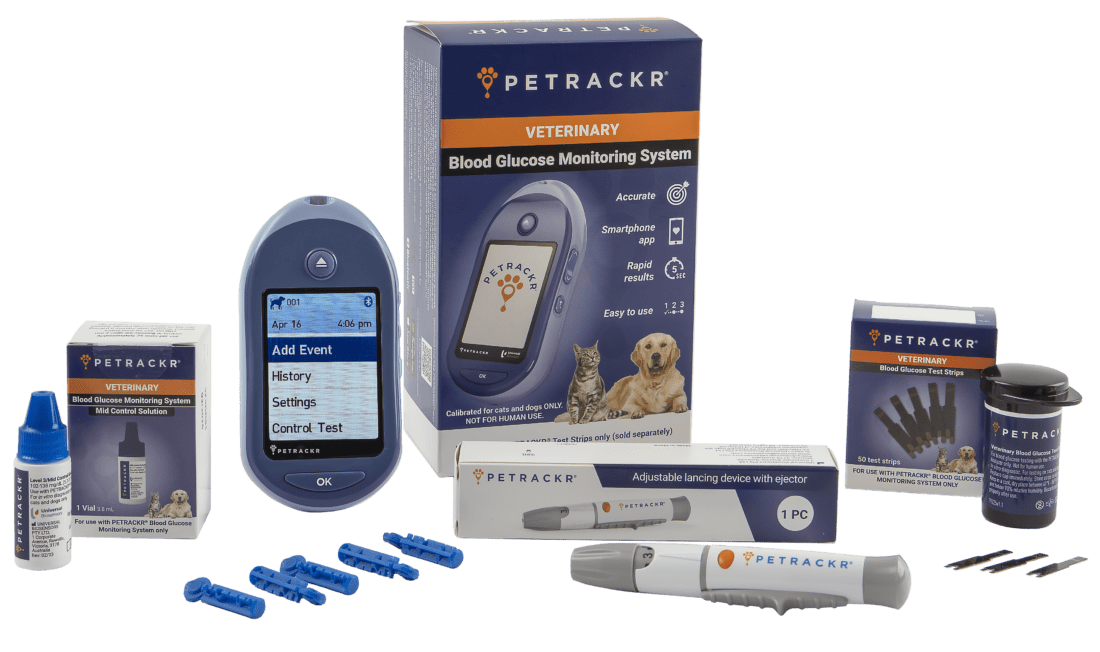Written & Reviewed by an approved Veterinary Medical Writer

Human v Veterinary Glucose Monitoring
Monitoring glucose levels is vital for managing health, both in humans and pets. But the methods and nuances in tracking these levels differ between the two. Human glucose monitoring is tailored to our lifestyles, offering a range of techniques from traditional tests to advanced systems.
On the other hand, pets have unique needs, and their trackers prioritise stress reduction and comfort as well as ease of use for the pet parent. As we examine the differences in glucose monitoring, we’ll uncover the distinct approaches for humans and animals, ensuring optimal health outcomes for all.
Why is glucose monitoring important for both humans and pets?
Glucose monitoring holds immense importance for both humans and pets due to its direct impact on overall health. Glucose serves as a vital energy source for cells, and maintaining its balance is essential.
In humans, consistent glucose monitoring is particularly crucial for those managing conditions like diabetes and conditions causing low blood sugar, as fluctuations can lead to severe health complications. By tracking glucose levels, individuals can make informed decisions about medication, diet, and lifestyle adjustments.
Similarly, pets benefit from glucose monitoring, especially those at risk of diabetes. Regular monitoring enables early detection of potential health issues, allowing timely interventions for improved well-being. In essence, glucose monitoring empowers individuals and pet owners alike to proactively safeguard health and enhance the quality of life for both humans and their beloved animal companions.
How do I monitor glucose in both myself and my pets?
Monitoring glucose in both humans and pets involves specific methods and tools designed for each. Here’s a brief guide:
For humans
- Fingerstick Blood Tests: The most common method where you prick your finger using a lancet, and then place a small drop of blood on a test strip. This strip is then inserted into a glucose metre which gives a reading.
- Continuous Glucose Monitors (CGMs): These are wearable devices that measure glucose levels in real-time throughout the day and night. They use a tiny sensor inserted under the skin which automatically records glucose levels.
- Haemoglobin A1C Test: This is a lab test done at your doctor’s office that provides an average of your blood sugar levels over the past 2-3 months.
For pets
- Continuous Glucose Monitor (CGM): Veterinarians may place a human Continuous Glucose Monitor (CGM) on a pet who needs frequent monitoring throughout the day for 10-14 days, such as a hospitalised patient. At this time, no CGMs are approved for use in veterinary patients. These monitors give slightly different results than blood glucose metres calibrated for pets.
- Blood Glucose Metres: These are similar to human metres, but they are calibrated for pets. The process involves taking a small blood sample, usually from the ear edge or paw pad, and placing it on a test strip.
- Urine Glucose Test: Although less accurate, urine tests can help determine if a pet’s glucose level is high. Special test strips change colour when dipped in urine containing glucose. Urine Glucose Testing is less reliable at detecting low glucose levels.
Tips for both
- Always consult with a healthcare professional or veterinarian before beginning any glucose monitoring regimen. Only change an insulin dose based on your veterinarian’s advice.
- Ensure that you’re using the right tools: human metres shouldn’t be used for pets.
- Keep a consistent log of readings, which can be very helpful for spotting trends or for consultations with medical or veterinary professionals.
- Monitor regularly and be aware of factors that might affect glucose levels, such as food, exercise, stress, or illness.
Benefits of portable glucose monitoring for both humans and dogs
Portable glucose monitoring offers a host of advantages for managing diabetes in both humans and dogs, revolutionising the way we approach this chronic condition. The convenience of these devices, such as the PETRACKR for pets, allows for quick and accurate blood glucose measurements without the need for a clinic or hospital visit. This not only reduces stress for your pet but also gives you peace of mind. For humans, portable glucometers offer similar benefits, allowing for more frequent and accurate readings compared to traditional methods like urine tests. Blood glucose monitoring allows people or pet parents to recognise worrisome glucose values or trends right away. With these values, their medical professionals can give higher quality care and advice.
The benefits extend beyond mere convenience and immediate action; these devices also facilitate a deeper understanding of how lifestyle choices impact blood sugar levels. By tracking meals, exercise, medication, and other variables, users can identify patterns and make informed health management decisions.
However, it’s essential to remember that while portable glucose monitors are invaluable tools, they should not replace regular consultations with healthcare providers. Both your veterinarian and doctor are integral to your comprehensive treatment plan, offering expert guidance to ensure optimal care. In summary, portable glucose monitoring is a transformative tool for diabetes management in both humans and dogs, providing real-time data, convenience, and a greater sense of control over this chronic condition. It’s an investment in health that pays dividends in improved well-being and peace of mind.
Why shouldn’t I use a glucose monitor intended for humans on my pets?
Using a glucose monitor intended for humans on pets is not recommended due to several important reasons:
Calibration differences
Using a glucose monitor not designed for pets on your furry companions can result in inaccurate readings due to calibration differences. This is because glucose levels in a pet’s blood can vary from those in humans.
Species-specific considerations
Pets possess unique physiology compared to humans, impacting their glucose readings. Factors like blood composition, circulation, and metabolic rates can all affect accuracy. Pet-specific monitors are designed to address these considerations.
Accuracy concerns
Achieving accurate glucose readings is vital for managing health conditions. When applied to pets, human glucose monitors may not be precise due to variations in blood samples and the device’s calibration range, potentially leading to misguided health decisions.
Veterinary recommendations
Relying on the expertise of veterinarians is crucial for your pets’ health. Veterinary professionals are trained to understand animal health intricacies and have access to specialised monitors calibrated specifically for pets, ensuring more dependable results.
Impact on treatment
Inaccurate glucose readings can have serious consequences for your pets’ treatment plans. Incorrect decisions based on flawed data may jeopardise their well-being or lead to ineffective treatments.
Safety and comfort
Opting for pet-friendly glucose monitors ensures that your animals’ comfort and safety are prioritised during testing. Pet glucose metres often have smaller needles on their lancets and need a smaller amount of blood for testing. Human monitors have larger needles and require more blood. Using monitors intended for humans can distress pets and introduce unnecessary stress during the monitoring process.
Manufacturer warranties
Employing a glucose monitor in unintended ways, such as using one designed for humans on pets, can void the manufacturer’s warranty. This would leave you without recourse or support in case the device malfunctions or encounters issues.
In summary, to ensure accurate and reliable glucose monitoring for your pets, it’s best to use monitors specifically designed and calibrated for them. Always consult with a veterinarian who can guide you on the appropriate monitoring methods for your pets.
Where can I get the best glucose monitor for my pets?
Introducing the PETRACKR Blood Glucose Monitoring System—a breakthrough solution designed specifically for cats and dogs that is available through veterinary distributions and can be acquired through your veterinarian. This innovative system offers swift and accurate glucose monitoring, seamlessly integrated with the PETRACKR® app for effortless data recording, monitoring, and reporting.
Derived from a leading human blood glucose product, PETRACKR ensures reliability and accuracy, comparable to laboratory analysers. Rapid results are delivered with minimal sample sizes, providing glucose readings within seconds. The system’s user-friendly design includes a convenient sample disposal eject button, enhancing safety and hygiene.
Simplicity reigns with the PETRACKR system. Data collection and management become effortless, further streamlined through its integration with the PETRACKR app. The app offers customizable pet profiles, granting insight into glucose history at your fingertips. Plus, coding complexity is eliminated, as the system auto-calibrates for cats and dogs.
The PETRACKR Blood Glucose Monitoring System embodies precision, convenience, and user-friendliness, revolutionising pet care through advanced technology and ease of use. Elevate your pet’s health with this unparalleled monitoring solution.
Visit our website to learn more information and get a blood glucose monitor for your pets!
Sources:
- https://www.aaha.org/aaha-guidelines/diabetes-management/treatment/insulin-therapies/
- https://www.healthdirect.gov.au/blood-glucose-test
- Peña LW, Flatland B, Behrend EN, Arzón-Pereira A, Cole JE, Raz ML. Impact on result interpretation of correct and incorrect selection of veterinary glucometer canine and feline settings. J Vet Diagn Invest. 2023;35(6):710-720. doi:10.1177/10406387231195386
- Cohen TA, Nelson RW, Kass PH, Christopher MM, Feldman EC. Evaluation of six portable blood glucose meters for measuring blood glucose concentration in dogs. J Am Vet Med Assoc. 2009;235(3):276-280. doi:10.2460/javma.235.3.276
- https://www.universalbiosensors.com/products/petrackr/
